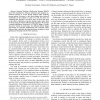Free Online Productivity Tools
i2Speak
i2Symbol
i2OCR
iTex2Img
iWeb2Print
iWeb2Shot
i2Type
iPdf2Split
iPdf2Merge
i2Bopomofo
i2Arabic
i2Style
i2Image
i2PDF
iLatex2Rtf
Sci2ools
93
Voted
ICRA
2007
IEEE
2007
IEEE
Dynamic Guidance with Pseudoadmittance Virtual Fixtures
— Human Machine Collaborative Systems (HMCS) have been developed to enhance sensation and suppress extraneous motions or forces during surgical tasks requiring precise motion. However, to date such systems have enforced constraints on the position or path of a tool, but have not considered the dynamics of motion. Also, the focus has been on the effect of guidance of motion during a task, rather than on the learning of motion skills through repetition. We present a pseudo-admittance framework for HMCS design to guide the user’s velocity in such tasks. Two different fixture design approaches are analyzed, implemented and compared. Three tests are then conducted, showing the fixtures’ promise for both guiding and learning motions with dynamics.
| Added | 03 Jun 2010 |
| Updated | 03 Jun 2010 |
| Type | Conference |
| Year | 2007 |
| Where | ICRA |
| Authors | Zachary A. Pezzementi, Allison M. Okamura, Gregory D. Hager |
Comments (0)

